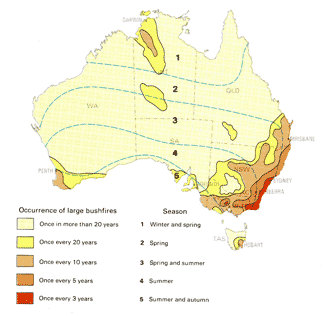Existing legislation & policy
Historical experiences of fire in settler society have influenced the development of legislation and policy. In this section we explore the legislation, and organisations, responsible for fire management in the jurisdictions of northern Australia.
The purpose of much legislation is to reduce and control wildfires by the judicious use of preventative controlled burning, and by allowing fires to be lit by the public at approved times.
These laws relating to fire should also be considered in relation to other Acts, such as those governing the management of national parks, and Acts that protect Native Title rights.
In each state there is an authority charged with issuing burning permits, providing advice to the public and with undertaking prescribed burning aimed at reducing subsequent wildfires.
Activity: Bushfires and Acts
What laws regulate burning?
Following is a list of the legislation governing the control of bush fires (non-urban fires) in each of the three jurisdictions in northern Australia. Acts generally have a paragraph explaining their overall purpose. Find a copy of the act for each jurisdiction listed below, and find this paragraph, located at the end of the Table of Contents, immediately between the title of the Act and the body text.
How similar is the purpose of each Act, and what aspects of environmental management (if any) are mentioned?
Resources:
Queensland Fires and Rescue Service Act 1990.
Northern Territory Bushfires Act 2004 and Bushfires Amendment Act 2003.
Western Australia Bush Fires Act 1954. In particular refer to Part III.
Activity: Bushfires authorities
Who implements the Acts?
Each of these Acts provides for the establishment of an authorising body, which provides advice on fire management issues. Use the following links to find out more about these authorities. You may well liaise with them in the future, if you continue in a profession that involves fire ecology and management in northern Australia.
Use the following links to familiarise yourself with the objectives and aims of these three organisations. What aspects of environmental management are mentioned in their objectives and aims?
Resources:
Find the website of your local equivalent of the Country Fire Authority.
Queensland: QLD Rural Fire Service within Queensland Fire & Rescue Service
Northern Territory: NT Bushfires Council
Western Australia: Bush Fires Services, within the Fire & Emergency Services Authority (FESA)Activity: Fire management policy
How does northern Australia burn?
Lighting fires is generally regulated. At certain times of the year, in certain fire management areas or under certain conditions burning is only allowed under permit. In Western Australia permits to burn are issued by Local Government, while FESA provides advice to local governments on fire management issues. In the Northern Territory permits to burn are issued by the NT Bushfires Council. In queensland, permits to burn are issued by Fire Wardens in the Rural Fire Service.
Early in the fire season, fires are expected to be cooler and more easily controlled. At this time, fire authorities focus on prescribed burning with the aim of preventing uncontrolled, more destructive wildfires later in the season. This is the time of year when fires are lit to create firebreaks and reduce fuel loads. However later in the fire season fire management authorities focus on fire control and fire fighting, extinguishing rather than lighting fires.
Using the fire authority websites, find out the conditions under which burning is allowed, and when and where permits apply, in your jurisdiction.
Resources:
Queensland
Rural Fire Service (2004) Accessed September 2005.
Queensland Fires and Rescue Service Act 1990. In particular refer to Parts 7 and 8 of the Act.Northern Territory
Bushfires Council NT (2005). Home page accessed September 2005. In particular refer to the brochure entitled “Basic Fire Laws” linked to these pages as a PDF file.Western Australia
Western Australia Bush Fires Act 1954. In particular refer to Part III.
Bush Fires Service, within the Fire & Emergency Services Authority (FESA).Fire seasons
Using the 'North Australia Fire Information' website look at when fires occurred last year. Select a region in your state (e.g. Victoria River District, East Kimberley, Cape York etc.) and use the fire scar maps of the most recent fire season to determine when most fires occurred on the ground in the area you have chosen. Compare this to the scars from previous years, if this information is available for your area.Large Bushfires
Following is a map of ‘Large Bushfires’ published in Johnson (1992). Compare your observations of burning patterns and distributions on the North Australian Fire Information website maps, with that presented in the Large Bushfires map.What discrepencies do you note, and how would you explain these differences? How does the concept of ‘large bushfires’ differ from north to south?Map of large bushfires (click image for a larger view)
Johnson, K. (1992). The AUSMAP atlas of Australia, p.77.Cambridge University Press, Oakleigh Victoria.
![]()
